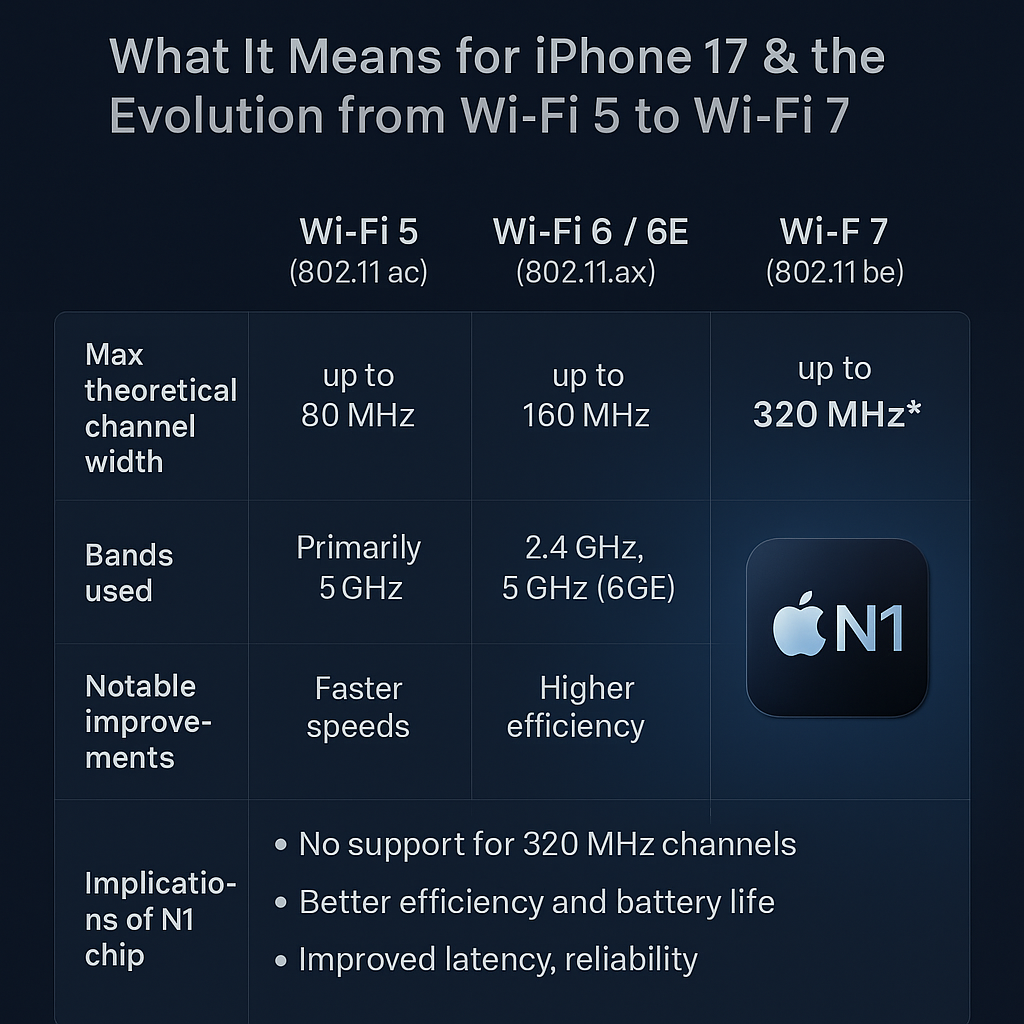
Table of Contents
As wireless standards evolve rapidly, device-makers and consumers alike are trying to keep pace with what the latest chips can actually deliver — especially when vendors begin advertising new WiFi capabilities. Apple’s newly introduced N1 wireless networking chip in the iPhone 17 line is a case in point. While this custom chip supports WiFi-7, Apple has confirmed it does not support the full 320 MHz channel width that WiFi-7 theoretically allows. What does that mean for real-world speeds? And how should buyers think about WiFi-5, WiFi-6, and WiFi-7 when making device or router decisions? Let’s break it down.
What Wccftech Found: Apple’s N1 Chip & Its Limitation
According to the recent Wccftech article, the new N1 chip in all iPhone 17 models supports channel widths up to 160 MHz, but not 320 MHz. Wccftech
- The 320 MHz channel is one of the hallmarks of WiFi-7 (802.11be), enabling much greater theoretical throughput.
- Apple has opted (for now) to omit support for that max-width channel. The reason? In practical terms, many networks and service providers can’t deliver bandwidth that high, so the marginal gains may not justify costs in power, complexity, or hardware.
- On the plus side, Apple claims the N1 improves efficiency, battery life, hotspot and peer-to-peer transfer performance compared to earlier chips.
In short: iPhone 17 and the N1 chip bring real improvements, but they stop short of enabling WiFi-7 in its fullest theoretical form.
WiFi-5, WiFi-6, WiFi-7: What’s Changed & Why It Matters
To understand the significance, it helps to review what the progression of WiFi standards has brought us, especially in terms of channel width, speed, and real-world trade-offs.
| Feature | WiFi-5 (802.11ac) | WiFi-6 / 6E (802.11ax) | WiFi-7 (802.11be) |
|---|---|---|---|
| Max theoretical channel width | up to 80 MHz (some early 160 MHz in select devices) | typically 80 MHz, many devices support 160 MHz (and 160 in 6 GHz band with 6E) | up to 320 MHz |
| Bands used | Primarily 5 GHz | 2.4 GHz, 5 GHz; WiFi-6E adds 6 GHz | Same bands, expanded 6 GHz use; ability to aggregate bands more flexibly |
| Speed / Throughput improvements | Huge jump over 802.11n; faster single-stream speeds, more spatial streams | Higher spectral efficiency; better performance in congested environments; more streams; lower latency | Even higher throughput, lower latency; supports wider channels; better for ultra-high data applications like AR/VR, ultra-HD streaming, etc. |
| Real-world trade-offs | Limited by congestion, interference, and practical limitations of equipment | Better handling of many devices; more robust performance; but wide channels can be harder to find relatively interference-free spectrum | Theoretical speed gains depend heavily on access to wide, clean spectrum; more power consumption; hardware complexity |
Where Apple’s N1 Fits in
Given that background, here are implications of Apple’s decision to cap channel width at 160 MHz on the iPhone 17 + N1 chip:
- No full WiFi-7 maximum throughput, but still very fast.
If your network and ISP connection already don’t reach speeds that would need 320 MHz of bandwidth, you may not notice any bottleneck from this design choice. - Better efficiency and battery life.
Wider channels (e.g. 320 MHz) often consume more power and are more vulnerable to interference. By staying at 160 MHz, Apple may balance performance gains with battery usage, reliability, and thermal constraints. - Latency, reliability, and multi-band performance are still likely improved.
Even without 320 MHz, WiFi-7 introduces enhancements (improved scheduling, multi-band operation, lower latency) that benefit more than just raw speed. For many users, these updates will feel “better internet” even if top throughput isn’t vastly higher. - Spectrum and infrastructure bottlenecks.
Many routers and ISPs do not yet support 320 MHz channels, especially in consumer or mixed-use environments. There can be regulatory constraints, or simply lack of clean spectrum. Thus, even if the phone supported 320 MHz, users might rarely get the chance to use it. Apple appears to have considered that in its design.
What This Means for You (and for Router / Device Buyers)
If you’re shopping for a new router, using WiFi in a dense environment, or planning to buy the iPhone 17 (or comparable devices), here are some takeaways:
- Don’t chase specs blindly. A router that says “supports 320 MHz” doesn’t necessarily give benefit unless your device, the network, and the ISP all line up.
- Prioritize real-world signals. If you want better WiFi, look for higher spectral efficiency (e.g. OFDMA, improved MU-MIMO), better multi-band coverage (especially 6 GHz for WiFi-6E / WiFi-7), strong signal strength, and low interference, not just max channel width.
- Expect more gradual adoption of 320 MHz. As routers, infrastructure, and regulatory environments support wider channels over time, 320 MHz may become more useful. But for now, it’s a “nice to have” rather than a “must have” for most users.
- Balance power vs speed. For mobile devices, battery life and reliability often matter as much (or more) than absolute top speed. Apple seems to be optimizing in that direction with the N1 chip.
Conclusion
Apple’s N1 chip in the iPhone 17 brings in-house control, WiFi-7 capability, and improvements in efficiency and connection reliability. However, by not supporting the full 320 MHz channel width of WiFi-7, there is a cap on raw throughput. For many users, that cap may not be noticeable — especially given prevailing network capabilities, ISP speed limits, and environmental constraints.
Understanding the distinctions between WiFi-5, WiFi-6, and WiFi-7 — especially around channel width, bands, and real-world tradeoffs — is key to making smart choices when buying routers or devices. As always, specs are part of the story, but performance in your home, with your devices and your usage, matters even more.

